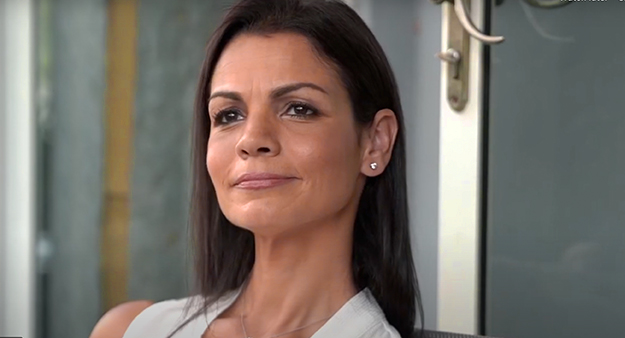
HPV is more common
than you may think.1
But helping to protect yourself from certain HPV-related cancers and diseases is within reach.1,2 For most people, HPV clears on its own. But for those who don’t clear the virus, it can cause certain cancers and diseases.3-5

Persistent HPV
infection can lead to certain cancers and diseases.1
Human papillomavirus, or HPV, is a virus that most sexually active people will have at some point in their lives. It is also the most common sexually transmitted infection (STI) in the world.2
For most people, HPV clears on its own. But for others, HPV infection persists, and can lead to serious consequences, like HPV-related cancers and diseases.1,3
Separate fact from myth.
Learn the truth about HPV.

AM I AT RISK?
Could you be at risk for certain HPV-related diseases?
For most people, HPV clears on its own. But for those who don’t clear the virus, it can cause certain cancers and diseases.1-3 HPV is the most common sexually transmitted infection in the world. In fact, it’s so common that most sexually active men and women will get the virus at some point in their lives. Since HPV usually has no symptoms, you can be infected and not even know it.1
The good news? Regardless of wherever you are in your life, there are steps that you can take to help lower your risk of an HPV infection and developing certain HPV-related diseases.4,5
HPV PREVENTION
Life doesn’t wait, neither should you. Helping protect yourself can start today.1
You can make the empowering decision to help protect yourself from certain HPV-related cancers and diseases.1,2 To start, have an open conversation with your healthcare professional about the options that are appropriate for you, including HPV vaccination—and get started on the path to protection.1

FREQUENTLY ASKED QUESTIONS
Get answers to your questions about HPV.
HPV, also called human papillomavirus, is a virus that infects the skin or various mucous membranes. There are many different types of HPV, some of which can cause certain types of cancer and genital warts.1 For most people, HPV clears on its own. But for those who don’t clear the virus, it can cause certain cancers and diseases.2-4
HPV is the most common sexually transmitted infection in the world and up to 80% of sexually active people will get HPV at some point in their lives.1
Men and women who are sexually active can be infected with HPV at some point in their lives.1 For most people, HPV clears on its own. But for those who don’t clear the virus, it can cause certain cancers and diseases.2-4
Anyone who has HPV can pass on the virus through direct skin-to-skin contact—usually through sexual activity.1 For most people, HPV clears on its own. But for those who don’t clear the virus, it can cause certain cancers and diseases.2-4
There are ways to help reduce the risk of contracting certain HPV-related cancers and diseases. These include:1,5
- Sexual abstinence
- Lifestyle-related risk factor changes
- Condom use
- Cervical cancer screenings
- HPV vaccination
Persons portrayed are not actual patients.
For demonstration purposes only.
- World Health Organization (WHO). Human papillomavirus vaccines: WHO position paper (2022 update). Wkly Epidemiol Rec. 2022;97(50):645-672
- World Health Organization. Questions and answers about human papillomavirus (HPV). https://iris.who.int/bitstream/handle/10665/376263/WHO-EURO-2024-5631-49185-73415-eng.pdf?sequence=1. Published 2024. Accessed March 21, 2024.
- Meites E, et al., Epidemiology and Prevention of Vaccine-Preventable Diseases (Pink Book). 14th edition. Chapter 11: Human Papillomavirus. Centers for Disease Control and Prevention. https://www.cdc.gov/pinkbook/hcp/table-of-contents/chapter-11-human-papillomavirus.html?CDC_AAref_Val=https://www.cdc.gov/vaccines/pubs/pinkbook/hpv.html Updated August 2021. Accessed June 10, 2024.
- Centers for Disease Control and Prevention. Sexually transmitted infections treatment guidelines, 2021 – human papillomavirus (HPV) infection. https://www.cdc.gov/std/treatment-guidelines/hpv.htm. Last reviewed July 22, 2021. Accessed June 6, 2024.
- Centers for Disease Control and Prevention. HPV and oropharyngeal cancer. https://www.cdc.gov/cancer/hpv/oropharyngeal-cancer.html?CDC_AAref_Val. Last reviewed November 14, 2023. Accessed May 16, 2024.
Myth or Fact
- World Health Organization. Questions and answers about human papillomavirus (HPV). https://iris.who.int/bitstream/handle/10665/376263/WHO-EURO-2024-5631-49185-73415-eng.pdf?sequence=1. Published 2024. Accessed March 21, 2024.
- Meites E, et al., Epidemiology and Prevention of Vaccine-Preventable Diseases (Pink Book). 14th edition. Chapter 11: Human Papillomavirus. Centers for Disease Control and Prevention. https://www.cdc.gov/pinkbook/hcp/table-of-contents/chapter-11-human-papillomavirus.html?CDC_AAref_Val=https://www.cdc.gov/vaccines/pubs/pinkbook/hpv.html. Updated August 2021. Accessed June 10, 2024.
- Centers for Disease Control and Prevention. Cancers caused by HPV. https://www.cdc.gov/hpv/about/cancers-caused-by-hpv.html?CDC_AAref_Val=https://www.cdc.gov/hpv/parents/cancer.html. Updated July 3, 2024. Accessed June 26, 2024.
- Centers for Disease Control and Prevention. HPV and oropharyngeal cancer. https://www.cdc.gov/cancer/hpv/oropharyngeal-cancer.html?CDC_AAref_Val. Last reviewed November 14, 2023. Accessed May 16, 2024.
- World Health Organization (WHO). Human papillomavirus vaccines: WHO position paper (2022 update). Wkly Epidemiol Rec. 2022;97(50):645-672
- World Health Organization: WHO. (2024, March 5). Human papillomavirus and cancer. https://www.who.int/news-room/fact-sheets/detail/human-papilloma-virus-and-cancer. Accessed 6 November 2024.
FAQs
- World Health Organization. Questions and answers about human papillomavirus (HPV). https://iris.who.int/bitstream/handle/10665/376263/WHO-EURO-2024-5631-49185-73415-eng.pdf?sequence=1. Published 2024. Accessed March 21, 2024.
- Meites E, et al., Epidemiology and Prevention of Vaccine-Preventable Diseases (Pink Book). 14th edition. Chapter 11: Human Papillomavirus. Centers for Disease Control and Prevention. https://www.cdc.gov/pinkbook/hcp/table-of-contents/chapter-11-human-papillomavirus.html?CDC_AAref_Val=https://www.cdc.gov/vaccines/pubs/pinkbook/hpv.html Updated August 2021. Accessed June 10, 2024.
- Sexually transmitted infections treatment guidelines, 2021 – human papillomavirus (HPV) infection. Centers for Disease Control and Prevention. Last reviewed July 22, 2021. https://www.cdc.gov/std/treatment-guidelines/hpv.htm. Accessed June 6, 2024.
- Centers for Disease Control and Prevention. HPV and oropharyngeal cancer. https://www.cdc.gov/cancer/hpv/oropharyngeal-cancer.html?CDC_AAref_Val. Last reviewed November 14, 2023. Accessed May 16, 2024.
- World Health Organization (WHO). Human papillomavirus vaccines: WHO position paper (2022 update). Wkly Epidemiol Rec. 2022;97(50):645-672
Copyright © 2025 Merck & Co., Inc., Rahway, NJ, USA and its affiliates. All rights reserved. MY-HPV-00091 Jan/2025




